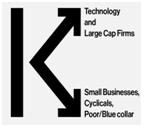

Context
About
- What is K-shaped recovery?
- The “K-shaped” economic recovery, is characterised by a stark split in the recovery pace of the economy— some sectors are bouncing back ahead of the rest at a much faster pace, while others are continuing a downward trajectory.
- K-shaped recovery occurs if different sectors recover at different rates.
Typical economic recoveries
- Typical economic recoveries can include Z, V, U, W and L:
- V-shaped recovery:A sharp decline followed by a rapid recovery, with very little time spent at the trough, or low point, of the recession.
- U-shaped recovery:A steep decline followed by a period of time in which the economy sits at the low point of the recession before finally recovering.
- W-shaped recovery:Also known as a double-dip recession, this is a scenario when the economy experiences a steep decline, followed by a small and temporary recovery and then a second decline.
- L-shaped recovery:A severe recession in which the economy declines and doesn't recover for years, if ever.
Consequences of a K-shaped recovery
- The K-shaped recovery, presaged for the present recession, may lead to changes in the economic and social structures.
- The affluent section of the market recovers at a rapid pace through solid capital allocation in assets priced at a bargain.
- Regular citizens of the economy who feel the heat of the downturn, dip into long-term savings to tide over the short-term.
- Daily wage earners and individuals who work in the gig industry, face the harsh reality of taking on debt to pay off on-going loans. This adds an additional debt burden which further worsens their situation in the long-term.


